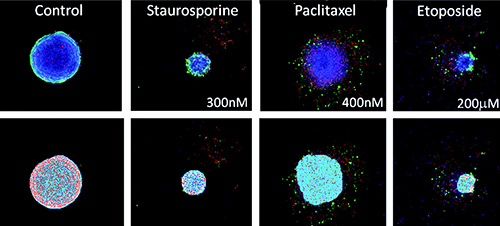Oksana Sirenko Ph.D. Molecular Devices
Trisha Mitlo Molecular Devices
Jayne Hesley Application Scientist Molecular Devices
Steve Luke Molecular Devices
Windsor Owens Molecular Devices
Evan F. F. Cromwell, Ph.D. Director of Assay Development Molecular Devices
Developing High-Throughput Compound Screening Methods for Cancer Drug Candidates
In vitro aggregates of stem cells and tumor cells called spheroids have been used for decades as models to recapitulate the in vivo tissue environment. Spheroids can be established from a single cell type or created from mixtures of multiple cell types such as tumor, stromal, and immune cells. Spheroids are believed to mimic tumor behavior more effectively than conventional two-dimensional (2D) cell cultures because spheroids, much like tumors, contain both surface-exposed and deeply buried cells, proliferating and nonproliferating cells, and well-oxygenated and hypoxic cells. In three-dimensional (3D) growth conditions, spheroids reproduce important parameters of tumor microenvironments, including oxygen and nutrient gradients. Spheroids have been used for breast cancer, colon,prostate, and other cancer disease modeling to identify novel anticancer therapeutics. 3D models have also been employed for developmental biology research and toxicity screening.
There has been significant progress in development of 3D cell models and techniques during the last several years. Hanging drop techniques use specialized plates and liquid handlers for media change and compound addition processes. Cells are then transferred to separate plates for analysis. Engineered microenvironments aid the formation of 3D structures in extracellular matrices (e.g., Matrigel) for screening of anticancer agents.Photolithographic techniques can form multiple spheroids on micropatterned surfaces or more complex organ-on-a-chip structures. Recently, spheroid formation in low-attachment round-bottom plates has become popular as the method offers a more simple workflow and is suitable for high-content imaging.
Different biological readouts from spheroid assays have been described. Common methods include disruption of spheroids and analysis of cell lysates or suspensions for adenosine triphosphate or other viability markers with microplate readers. High-content imaging methods have been demonstrated as promising techniques for characterizing the effects of chemical compounds and siRNA libraries on spheroids. Imaging has advantages over other analytical methods, such as plate reader-based luminescence or fluorescence, in that no disruption of the spheroids is required and multiple biological readouts are possible. Transmitted light (TL) imaging can be used to ascertain spheroid size and, to some extent, density. Fluorescence imaging can be used with viability dyes, DNA-binding dyes, apoptosis dyes, or other fluorescence markers. Alternatively, cells can be transfected with fluorescent proteins before spheroid formation to enable detection of changes in spheroid size or intensity by fluorescence. This method can be extended to more complex multicellular models that express a plurality of fluorescent markers.
Typically, low-magnification imaging is used to capture a full spheroid in one image and provide enough depth of field to sample farther into the center of the object. This approach limits assay readouts to changes in spheroid diameters or average fluorescence intensities or intensity ratios. The use of higher magnification provides single-cell resolution and the collection of more information about cellular content and spheroid structure. Higher magnification imaging also allows derivation of multiparametric outputs for characterizing complex phenotypes of spheroids treated with compounds. However, increased complexity introduces new assay development challenges, especially in a screening environment. The system must capture a relatively large object in one image and resolve individual cells in a thick solid object. Stains must penetrate inside spheroids. The analysis must enable comparisons between different spheroid phenotypes, derive IC50 values for compounds, show good assay reproducibility, and allow sufficient throughput.
The goal of this study was to develop and characterize high-magnification high-content imaging and image analysis methods suitable for high-throughput compound screening. We have optimized live cell protocols for spheroid assays using 10x and 20x objectives, 96-well or 384-well plates, and three commonly used cell lines: HCT116 (colon cancer), DU145 (prostate cancer cell line), and HepG2 (hepatocellular carcinoma). Sample handling steps for cell culture, treatment, and staining have been reduced to minimize spheroid disturbances and increase assay reproducibility. We have optimized and compared imaging methods and described measurements for multiparametric characterization of different spheroid phenotypes and determination of IC50 values. Furthermore, we characterized the assay using six benchmark cytotoxic compounds and compared IC50 values for 3D and 2D cultures. Finally, we have tested a small library of approved anticancer drugs (NIH-Approved Oncology Drugs Plated Set) in a wide range of concentrations and ranked compounds by potency. This method can enhance development of disease-relevant cell-based assays for efficient assessment of chemicals and drug candidates by high-throughput quantitative screening.
To read the rest of this article click here.
ASSAY & Drug Development Technologies, published by Mary Ann Liebert, Inc., offers a unique combination of original research and reports on the techniques and tools being used in cutting-edge drug development. GEN presents here one article "High-Content Assays for Characterizing the Viability and Morphology of 3D Cancer Spheroid Cultures."




